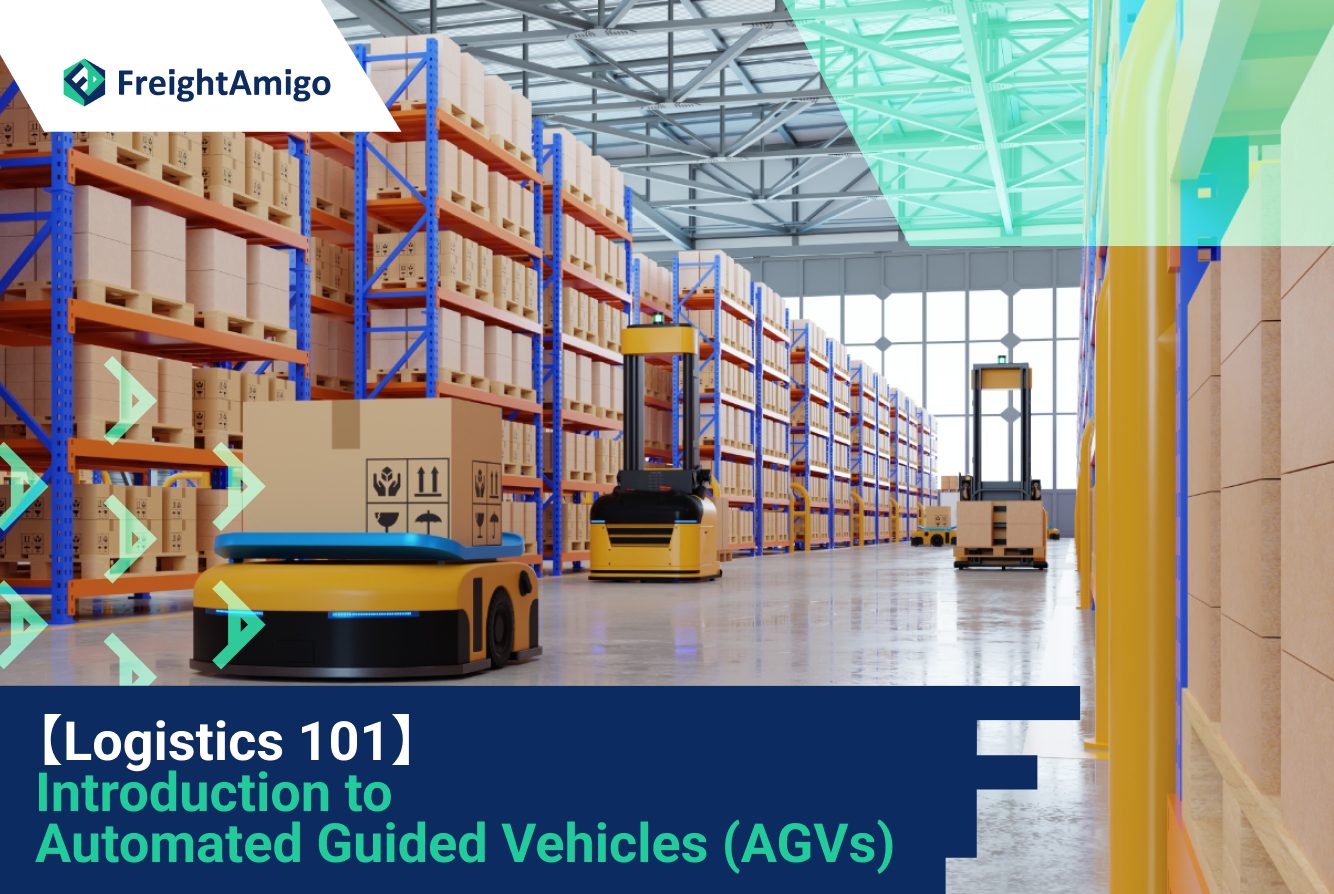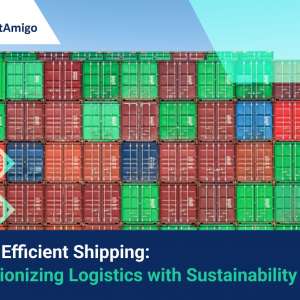In today’s fast-paced and highly competitive business environment, warehouse automation plays a crucial role in optimizing supply chain operations. One of the key components of warehouse automation is the use of Automated Guided Vehicles (AGVs). AGVs are self-guided vehicles that operate autonomously within a warehouse, distribution center, or manufacturing facility, eliminating the need for an onboard operator or driver. These intelligent machines are revolutionizing the way materials are handled, improving efficiency, productivity, and safety in various industries.
Author Name: Tiffany Lee – Marketing Analyst at FreightAmigo
What is an Automated Guided Vehicle (AGV)
An Automated Guided Vehicle (AGV) is a driverless transport vehicle used for carrying out material handling tasks autonomously within factories, warehouses or other facilities. They are commonly used to replace manual handling or transportation vehicles in order to improve efficiency, reduce costs and enhance operational safety.
AGVs are usually equipped with a guidance system, sensing devices and control systems that allow them to autonomously navigate predefined paths and interact with the surrounding environment. They can follow predetermined routes, dock at fixed points and automatically load and unload cargo as needed. Guidance systems typically use technologies like magnetic tapes, ground markers, laser guidance or vision guidance to provide path instructions.
Industries for Automated Guided Vehicle (AGV) Applications
Automated Guided Vehicles (AGV) have wide applications across various industries, with some of the major application industries including:
- Warehousing and logistics: AGVs are widely used in warehousing and logistics industries. They can be used for cargo handling, replenishing storage areas, transportation between racks and sorting and distributing cargo. AGVs help improve efficiency and accuracy within warehouse operations while reducing labor costs and human errors.
- Manufacturing: In manufacturing industries, AGVs can be used for material supply and transportation on production lines. They can transport raw materials from warehouses to production lines, and also transport finished or semi-finished products from production lines to the next workstation or storage areas. This helps improve production line efficiency and reduce material transportation time and costs.
- Ports: AGVs have extensive applications in ports. They can be used for cargo handling and stacking operations, assisting with container loading and unloading, stacking and transportation. AGVs can autonomously navigate within ports, following predefined routes and transporting cargo to designated locations as needed. This helps improve cargo handling efficiency in ports while reducing manpower investments and operational time.
- Healthcare: Applications of AGVs in the healthcare sector are growing. They can be used for internal material transportation in hospitals, such as transportation of drugs, samples and medical equipment. AGVs help ensure fast and safe material delivery while reducing human errors and risks of cross-contamination.
- E-commerce: In e-commerce industries, AGVs can be used for order picking and cargo transportation within warehouses. They can automatically retrieve ordered items from warehouses and accurately transport them to packaging or shipping areas. This helps improve order processing speed and accuracy while reducing labor costs.
- Food and beverages: AGVs also have wide applications in the food and beverage industries. They can be used for material transportation during food processing, such as transporting raw materials from warehouses to production lines and transporting finished products from production lines to packaging areas. AGVs help ensure food safety and quality while improving production efficiency.
- Hazardous locations: AGVs can also be applied in some hazardous locations, such as chemical plants, oil refineries or nuclear power plants. They can autonomously perform material handling tasks in these dangerous environments, reducing the time and risks of worker exposure. AGVs can follow predefined routes to avoid hazardous areas and ensure safe material delivery.
Automated Guided Vehicle (AGV) Workflow
- Receiving tasks: AGVs typically receive tasks through a central control system or dispatch center. These tasks can include cargo transportation, material handling and positional navigation.
- Environmental perception: AGVs are equipped with various sensors like vision sensors, laser sensors, ultrasonic sensors to perceive the surrounding environment. Through sensor data, AGVs can detect obstacles, recognize landmarks and paths.
- Route planning: AGVs use onboard algorithms and map data to process and analyze collected environmental information to generate optimal routes. Routes consider obstacles, target locations and other conditions to ensure AGVs can safely and efficiently reach destinations.
- Automatic navigation: Perform automatic unmanned loading transportation by preset route program, automatic or manual loading of cargo.
- Cargo handling: If the task involves cargo transportation, AGVs use various devices and mechanisms like lifting arms, conveyor belts or suction cups to handle and transport cargo. It can automatically transfer cargo from one location to another and perform stacking or unstacking when needed.
- Task completion and reporting: Once the AGV completes a task, it will send a report to the central control system or dispatch center to notify task completion status. This includes successful cargo delivery, arrival at destination and other relevant information. It also has functions such as real-time cargo status recording through storage compartment photography and weighing.
Key Features of Automated Guided Vehicles (AGV)
- AGVs have autonomous navigation capabilities to move autonomously within designated areas, following predetermined routes or avoiding obstacles. They use sensors and onboard maps to identify the environment and localize themselves, enabling accurate navigation.
- AGVs can be applied in different scenarios and industries like manufacturing, warehousing logistics, healthcare and more. They can perform tasks like cargo transportation, material handling, equipment replenishment and rack loading/unloading to improve work efficiency and reduce labor costs.
- AGVs have safety functions to detect and avoid obstacles, and stop or emergency stop when required. They are typically equipped with safety sensors, anti-collision devices and emergency stop buttons to ensure no danger to personnel or equipment during operations.
- AGVs are highly automated systems that can complete tasks with little or no human supervision or intervention. They can connect to central control systems or warehouse management systems to receive task instructions and report task completion, enabling efficient logistics management and operations.
- AGV systems can be scaled and configured as needed. Additional or replacement AGVs can be added, routes and tasks adjusted to adapt to different workspaces and business requirements. This flexibility allows AGV systems to adapt to changing production environments and needs.
Applications of AGVs in Material Handling
AGVs are used in a wide range of applications, replacing traditional manual material handling methods. They are particularly effective in repetitive tasks that were previously handled by forklifts, conveyor systems, or manual carts. Let us explore some of the common applications of AGVs in material handling:
1.Raw Materials Transportation
AGVs are widely used for transporting raw materials such as metal, plastic, rubber, or paper. They can efficiently transport these materials from the receiving area to the warehouse or directly to the production lines. By automating this process, AGVs ensure a continuous supply of raw materials without human intervention, preventing production line interruptions and improving overall productivity.
2. Work-in-Process (WIP) Applications
In work-in-process applications, AGVs play a vital role in moving materials or parts from the warehouse to production lines or between different workstations. By providing repetitive and efficient movement of materials throughout the manufacturing process, AGVs help to maintain a smooth workflow and prevent delays in production caused by material shortages.
3. Inbound and Outbound Handling
AGVs are also used for inbound and outbound handling tasks, such as replenishment and picking. They can transport inventory from receiving areas to storage locations or from long-term storage to forward picking locations for restocking. This ensures that the necessary inventory is readily available for pickers, streamlining the order fulfillment process and improving overall efficiency.
4. Collaborative Picking and Packing
Collaborative mobile robots, a type of AGV, are highly effective in the picking and packing process. These robots guide warehouse associates through their tasks, reducing human errors and optimizing the picking process. They can transport picked orders to packaging and shipping workstations, further streamlining the order fulfillment process.
These are just a few examples of how AGVs are transforming material handling operations in warehouses, distribution centers, and manufacturing facilities. By automating these tasks, AGVs improve efficiency, reduce labor costs, and enhance overall productivity.
Types of Automated Guided Vehicles
AGVs come in various types and configurations, each designed to cater to specific material handling requirements. Let us explore some of the most common types of AGVs:
1. Automated Guided Carts (AGCs)
Automated Guided Carts (AGCs) are the most basic type of AGVs. They are equipped with simple navigation systems, such as magnetic tape or sensor-based navigation, and can transport a variety of materials, from small parts to loaded pallets. AGCs are commonly used in sorting, storage, and cross-docking applications.
2. Forklift AGVs
Forklift AGVs are designed to perform the same functions as human-operated forklifts, but without the need for a human operator. They are capable of efficiently transporting pallets and are widely used in warehouse and manufacturing environments.
3. Towing AGVs
Towing AGVs, also known as tugger AGVs or driverless trains, are capable of pulling one or more non-powered, load-carrying vehicles behind them in a train-like formation. They are often used for transporting heavy loads over longer distances and can have multiple drop-off and pick-up stops along a defined path.
4. Unit Load Handlers
Unit Load Handlers are AGVs designed to carry discrete loads, such as individual objects or a single unit like a pallet or tote containing multiple items. They provide efficient and reliable transportation of these loads within the facility.
5. Heavy Burden Carriers
Heavy Burden Carriers are specifically designed to handle the heaviest loads in applications such as large assembly, casting, and coil and plate transport. These AGVs often have self-loading capabilities and various steering mechanisms to handle the weight and maneuverability requirements of heavy loads.
6. Autonomous Mobile Robots (AMRs)
Autonomous Mobile Robots (AMRs) are the most technologically advanced type of AGVs. Equipped with intelligent navigation capabilities, such as sensors and camera systems, AMRs can dynamically navigate a warehouse or facility and plan the most efficient paths. They can adapt to changes in the environment and avoid obstacles without the need for additional infrastructure modifications.
Each type of AGV offers unique advantages and is tailored to specific material handling needs. By choosing the right type of AGV for their operations, businesses can optimize their material flow and improve overall efficiency.
How Automated Guided Vehicles Work
AGVs operate using a combination of software, sensors, and navigation systems. While the specific mechanisms may vary depending on the type of AGV, there are common elements in their functioning. Let’s take a closer look at how AGVs work:
Automated Guided Vehicles Navigation
AGVs can navigate their environment using various navigation mechanisms. These include:
- Magnetic Guide Tape: Some AGVs use magnetic sensors to follow a track created by magnetic tape placed on the floor.
- Wired Navigation: AGVs can also follow wire paths embedded into the facility floor. The wires transmit signals that the AGVs detect through antennas or sensors.
- Laser Target Navigation: AGVs equipped with laser transmitters and receivers use reflective tape on objects like walls and machines. The lasers reflect off the tape, allowing the AGVs to calculate the object’s angle and distance.
- Inertial (Gyroscopic) Navigation: AGVs use transponders embedded in the floor to verify that they are on the correct course.
- Vision Guidance: Some AGVs use cameras to record features along their route and rely on these recorded features for navigation.
- Geoguidance: Geoguided AGVs recognize objects in their environment in real-time to establish their location and navigate accordingly.
- LiDAR: AGVs equipped with LiDAR sensors transmit laser pulses to measure the distance between the robot and objects in its environment. This data is used to create a 360-degree map of the environment, enabling the AGVs to navigate and avoid obstacles without additional infrastructure modifications.
The navigation mechanism used by an AGV depends on the specific requirements of the facility and the level of flexibility and adaptability needed.
Automated Guided Vehicles Steering
AGVs use different steering mechanisms to control their movement. The most common steering control methods are:
- Differential Speed Control: This method uses two independent drive wheels driven at different speeds to turn the AGV. To move forward or backward, the two drives are driven at the same speed. Differential speed control is commonly used in AGVs that operate in tight spaces or near machines.
- Steered Wheel Control: Similar to the steering control in a car or truck, this method uses the drive wheel as the turning wheel. Steered wheel control offers more precise steering and smoother turning, making it suitable for towing applications.
- Combination Steering: AGVs equipped with combination steering have two independent steer/drive motors on diagonal corners of the AGV and swiveling castors on the other two corners. This allows AGVs to turn in any direction like a car and also drive in differential steering mode in any direction.
The choice of steering mechanism depends on the AGV’s specific application and maneuverability requirements.
Automated Guided Vehicles Traffic Control
To ensure safe and efficient movement within a facility, AGVs employ traffic control mechanisms. These mechanisms include:
- Zone Control: AGVs equipped with zone control rely on wireless transmitters and sensors to detect the presence of other AGVs in specific areas or zones. If the area is clear, a signal is sent to allow the AGV to enter or pass through. If another AGV is already present, a stop signal is sent to prevent collisions.
- Collision Avoidance: AGVs equipped with collision avoidance sensors use sonic or optical sensors to detect objects in their path and avoid collisions. These sensors transmit signals and wait for replies to determine if an object is present. Bumper sensors are another type of collision avoidance sensor commonly used in AGVs.
- Combination Control: AGVs can utilize a combination of zone control and collision avoidance sensors to provide robust collision prevention in all situations. This ensures safe and efficient movement even in complex environments.
By implementing these traffic control mechanisms, AGVs can navigate their environment safely and efficiently, avoiding collisions and optimizing material flow.
Benefits of Automated Guided Vehicles in Material Handling
The adoption of AGVs in material handling operations offers numerous benefits to businesses. Let us explore some of the key advantages:
1.Increased Efficiency and Productivity
AGVs operate autonomously, eliminating the need for human intervention in repetitive material handling tasks. By doing so, they improve the efficiency and productivity of warehouse and manufacturing operations. AGVs ensure consistent and reliable performance, setting the pace for workers and reducing unnecessary walking. Collaborative mobile robots, in particular, guide associates through each task, reducing human errors and improving order picking accuracy. By leveraging AI to optimize routes and prioritize work, collaborative mobile robots improve resource utilization and enhance overall productivity.
2. Consistent Costs
AGVs are typically acquired on a per-unit or per-rental basis, providing businesses with consistent costs compared to human labor, which can fluctuate based on market conditions and demand. This allows for better cost predictability and financial planning.
3. Flexibility
Some AGVs offer flexibility in terms of route changes. Unlike AGVs that require re-routing guide wires or other infrastructure modifications, these AGVs can easily adapt to changing requirements without significant modifications. Additionally, AGVs are a scalable solution, allowing businesses to add additional units based on demand, providing flexibility to meet evolving operational needs.
4. Space Optimization
Compared to traditional automation solutions like conveyor systems, AGVs require less space. Their compact size allows for narrower aisles and better space utilization within a warehouse or facility. AGVs are particularly useful in environments where space is limited, enabling businesses to maximize their storage capacity and operational efficiency.
5. Improved Safety
AGVs are designed with safety in mind. They are equipped with sensors and advanced navigation capabilities to avoid collisions and ensure safe operation. Advanced AGVs, such as AMRs, can dynamically navigate through a facility, optimizing paths to reduce aisle congestion and prevent injuries. By removing the need for human operators in potentially hazardous material handling tasks, AGVs contribute to a safer work environment.
The benefits of AGVs in material handling are clear. They enhance efficiency, reduce costs, provide flexibility, optimize space utilization, and improve safety in warehouse and manufacturing operations. By leveraging AGVs, businesses can streamline their supply chain, improve productivity, and gain a competitive edge in today’s rapidly evolving market.
Automated Guided Vehicles Integration and Smart Warehousing with FreightAmigo
To fully leverage the benefits of AGVs, businesses need expert guidance in AGV integration, warehouse layout optimization, and route planning. FreightAmigo, a leader in supply chain automation, collaborates with businesses to implement AGV solutions tailored to their specific needs. By monitoring and controlling AGVs in real-time, coordinating warehouse automation, and conducting data analysis and optimization, FreightAmigo achieves efficient smart warehousing.
With FreightAmigo’s expertise, businesses can optimize their material flow, improve warehouse efficiency, and enhance overall operational performance. By integrating AGVs into their supply chain processes, businesses can achieve seamless automation, reduce labor costs, and maximize productivity.
Is your operation ready to embrace the potential of AGVs? Consult FreightAmigo’s experts to assess your warehouse or fulfillment center’s maturity level and unlock the benefits of AGVs in smart warehousing. Contact FreightAmigo today to revolutionize your supply chain operations.
There Are Different Options For Cargo Transportation. If You Want To Choose The Most Convenient And Suitable Solution, It Is Best To Have The Full Support Of Logistics Experts! If You Are Planning To Ship Goods Overseas, Please Go To The FreightAmigo Page For Inquiries.
===
Read More:
Ship Now, Pay Later – 5 Cash Flow Management Tips for Businesses & SMEs
Explore the thriving trade market Southeast Asia
How to Streamline Purchase Order Management for Enhanced Supply Chain Efficiency
===
If you have any inquiries on logistics/supply chain, feel free to contact FreightAmigo now:
Chat with us online OR
Phone : +852 28121686
WhatsApp: +852 27467829









































